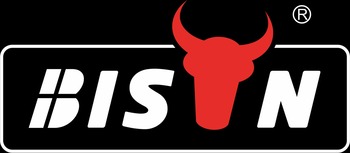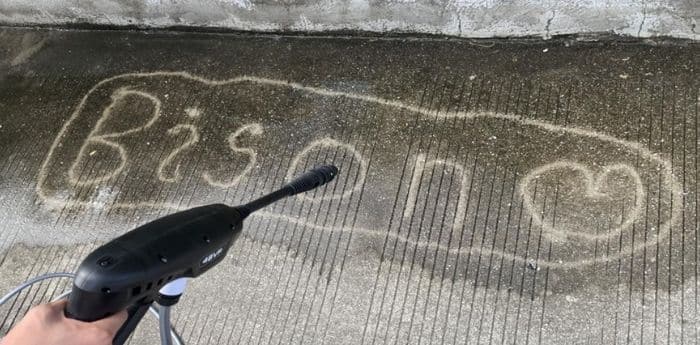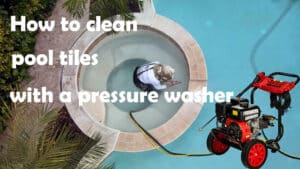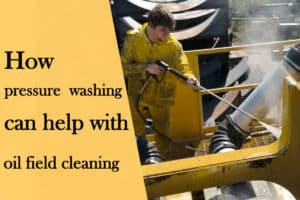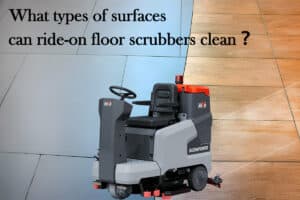In the world of exterior cleaning, two methods dominate the field: soft washing and pressure washing. Both have their unique strengths and applications, making them invaluable tools in maintaining cleanliness and aesthetics. This blog aims to provide an in-depth comparison of these two methods to help you make informed decisions.
We’ll look at pressure and soft washing, explain the key differences, and detail what to consider when choosing between the two.
What is soft washing?
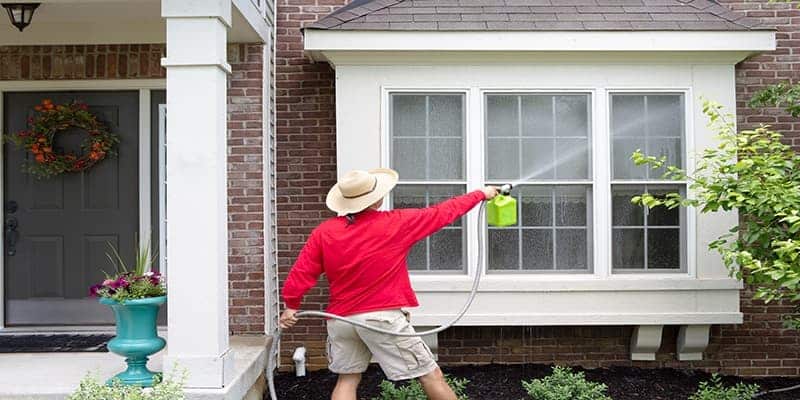
Soft washing is a cleaning method used to remove dirt, algae, mold, mildew, and other contaminants from surfaces such as roofs, siding, decks, and fences. Unlike pressure washing, Soft washing is particularly effective for delicate surfaces or areas where high-pressure cleaning could cause damagewhich uses high-pressure water to forcefully clean surfaces, soft washing utilizes low-pressure water combined with specialized cleaning solutions.
It’s worth noting that soft washing is different from pressure washing, which uses high-pressure water to physically blast away dirt and grime. Soft washing is a more gentle approach that focuses on chemical treatment and relies on the cleaning solution’s properties to effectively clean the surfaces.
Soft washing uses a pump sprayer with water spray and chemicals to effectively clean exterior surfaces. The typical pressure for soft-pressure washing is between 150-300 PSI
The use of low-pressure water and specialized cleaning solutions ensures a thorough and gentle cleaning process.
The soft washing process typically involves the following steps:
Inspection: The surface to be cleaned is inspected to identify the type and extent of contamination and determine the appropriate cleaning solution.
Pre-Treatment: A biodegradable cleaning solution is applied to the surface. This solution is usually a blend of water, detergents, and chemicals specifically formulated to kill and remove organic growth and stains.
Dwell Time: The cleaning solution is left on the surface for a specific period (dwell time) to allow it to penetrate and break down the contaminants.
Low-Pressure Rinse: After the dwell time, the surface is rinsed using low-pressure water, typically from a garden hose or a specialized soft washing system. The low-pressure rinse removes the cleaning solution along with the loosened dirt and contaminants.
Soft washing can be used to remove the following stains or buildup:
Mold, mildew and fungi
moss and weeds
algae and bacteria
grease
Wildlife debris
rust
organic matters
Soft washing benefits:
- Safety: Since it uses low pressure, soft washing minimizes the risk of damaging delicate surfaces like vinyl siding, aged wood, and shingles.
- Effective Deep Cleaning: The cleaning solutions used can penetrate deep into the surface, effectively eliminating organisms at their roots.
- Long-lasting Results: By killing organisms down to the root, soft washing ensures the cleaned areas stay clean for longer.
What is pressure washing?
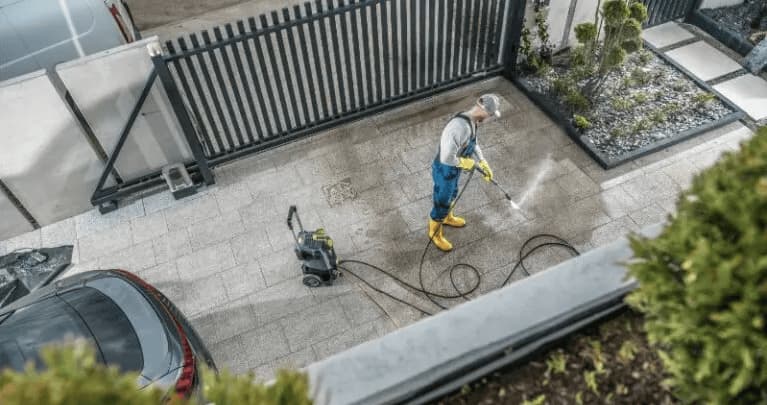
Pressure washing, or power washing, uses high-pressure water jets between 1,300-2,800 PSI to clean exterior surfaces. Pressure washing can remove many of the same stains and buildup as soft cleaning, including loose paint, mold, mud, dust, dirt, and grime. However, it usually does so without the help of chemicals, instead relying on water pressure to get the job done.
The power of pressure washing cannot be underestimated. Pressure-washing surfaces intended for soft washing pose a risk of damage. Mortar or grout can be removed from between bricks or tiles. Bitumen can be removed when cleaning the roof. Water damage can also occur when water under high pressure is inadvertently forced under a home’s siding. In all, caution must be exercised when pressure washing delicate materials or surfaces to avoid causing damage.
Therefore, pressure washing surfaces should primarily be limited to:Stone, garage floor, asphalt driveway, sidewalk, treated wood deck, patio
The process of pressure washing typically involves the following steps:
Preparation: The area or object to be cleaned is prepared by removing any obstacles, loose debris, or delicate items that could be damaged by the high-pressure water.
Equipment Setup: The pressure washer is set up and connected to a water source. Depending on the type of pressure washer, it may be powered by electricity, gasoline, or diesel.
Selecting the Nozzle: Pressure washers have different types of nozzles that produce different spray patterns and pressures. The appropriate nozzle is selected based on the surface and the level of cleaning required.
Application of High-Pressure Water: The high-pressure water jet is directed at the surface being cleaned. The force of the water dislodges and removes dirt, grime, and other contaminants. The operator typically moves the pressure washer nozzle in sweeping motions to ensure even coverage and thorough cleaning.
Optional Use of Detergents: In some cases, detergents or cleaning solutions may be applied to the surface before pressure washing to enhance the cleaning process. These detergents are specifically formulated for pressure washing and can help break down tough stains and dirt.
Rinse: After the pressure washing is complete, the surface is rinsed thoroughly with water to remove any remaining detergent or loosened debris.
Pressure washing benefits:
- Safety: Since it uses low pressure, soft washing minimizes the risk of damaging delicate surfaces like vinyl siding, aged wood, and shingles.
- Effective Deep Cleaning: The cleaning solutions used can penetrate deep into the surface, effectively eliminating organisms at their roots.
- Long-lasting Results: By killing organisms down to the root, soft washing ensures the cleaned areas stay clean for longer.
How pressure washing works
With pressure washing, you direct highly-compressed water at a surface to blast away contaminants. Pressure washers have different strength ratings in pounds per square inch (PSI).
Generally, pressure washing is considered the best method for removing loose paint or stains from surfaces – say, if you’re eliminating paints or stains to prepare for another layer.
The big drawback of pressure washing is that it can damage surfaces when misused. Applying high-powered pressure to a deck, for example, can cause severe damage to the surface. Wood is softer than concrete, so you must use a different PSI.
Use pressure washing:
- To remove loose paint or stain from wooden or aluminum siding
- To prepare a deck for staining
- To wash concrete, pavement, and similar hard surfaces that are more than three years old
How soft washing works
Soft washing is a lower-pressure wash. You still use higher pressure than you would with something like a hose, but soft washing allows you to dislodge contaminants without harming the surface.
Soft washing removes mold, algae, mildew, dirt, and other contaminants from a surface. You might use soft washing on a softer wood, for example, or to avoid impacting the structural integrity of concrete that’s newer than three years.
Use soft washing:
- For cedar shake siding, wood panel siding, and similarly soft siding materials
- To wash concrete that’s newer than 3 years old
- To clean mold, algae, mildew, dirt, and other surface contaminants without harming the surface below
- To clean outdoor wood furniture, rooted plants, screens, and enclosures
- To clean any standard surface, like a roof or a deck, where you don’t want to impact the structural integrity of that surface
Generally, for any standard cleaning of your house, deck, or property, soft washing is the right choice. If soft washing isn’t dislodging a specific trouble spot, you could switch to pressure washing.
Power washing vs pressure Washing
Some people use power washing, soft washing, and pressure washing interchangeably.
However, others claim there’s a difference between pressure and soft washing, with power washing being the heaviest-duty type available.
Power washing involves blasting high-pressure water (typically hot water) at a surface to sanitize and clean the surface.
Typically, power washing machines are industrial-grade machines designed for professionals – and they’re not safe for homeowners to use without proper training.
Power washers are commonly used in commercial and industrial settings, although they can also be spotted on driveways, stone walls, and rough concrete surfaces, among other areas.
When to avoid pressure/power Washing
So you know the difference between pressure wash and soft wash, and you know when to use them, so the only thing left to answer is simple:
When should you not use pressure washing?
The answer is straightforward. The things you soft-wash have never been pressure washed, and the things you have pressure washed have never been soft-washed. Most professional electric washers know when to use the soft wash system versus when to use the heavy wash method.
Pressure washing does use pressurized water at a specific PSI, depending on the surface, so background knowledge is recommended. Simply renting a pressure washer and going to a house in town isn’t always a good idea.
Improper pressure washing can damage the finish! This means you should be careful to pressure wash decks and wood surfaces and never pressure wash the following:
- Never pressure wash your roof
- Never pressure wash your siding
- Be cautious with high-pressure car washes
Contrary to what you might think, pressure washing roofs can be highly damaging to asphalt shingles. Pressure washing a roof can damage and weaken shingles, leading to more significant problems.
When to avoid soft washing
As stated above, “If you pressure wash it, don’t soft wash”. The list of what not to soft wash is pretty simple:
Do not soft wash colored concrete and hard surfaces.
Similar to an hour, if you pressure wash the wrong surface, problems can arise; the same goes for soft washing the bad surface.
With the help of soaps, chemicals, and detergents, it’s always best to consult a professional for soft household washing. Just like you don’t want to apply too much pressure, there are specific amounts when using soft washes to clean siding or roofs!
Conclusion
Soft washing and pressure washing each have their place in the cleaning industry. Understanding their differences and strengths will allow you to offer the best service to your clients, whether they need gentle cleaning or power washing.
Remember, the surface material, the size of the area to be cleaned, the available time, budget, experience of the operator, and the environmental impact are all factors that should guide your choice between soft washing and pressure washing.
We hope this guide provides valuable insights to help you make informed decisions. For more information about these methods or range of pressure washing equipment, feel free to contact us. We’re committed to providing top-quality products and knowledge to help you succeed in your pressure washing business.
Remember to keep up with Bison for more informative content and industry insights, Your success is our success, and we’re here to help every step of the way.
